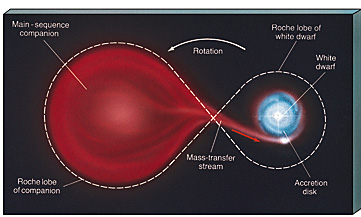Thorne and Żytkow's original paper on TŻOs actually opens with a comparison of TŻOs and the type of object you mention, with a white dwarf degenerate core instead of a neutron star degenerate core. They note that the equilibrium states - essentially, stable configurations - of such combinations lie near the Hayashi track (actually acting a bit like AGB stars, in some cases), indicating high metallicity, as is the case with TŻOs.
These objects generate energy the same way TŻOs do: matter is accreted by the core, releasing gravitational potential energy, and the red giant envelope continues some fusion, although, of course, core fusion has been substantially disrupted by the arrival of the new degenerate core. The main difference in energy production are the ratios between nuclear contributions to luminosity and gravitational contributions to luminosity:
$$L_{\text{nuc}}/L\approx0.99,\quad L_{\text{grav}}/L\approx0.01\quad\text{for white dwarf core}$$
$$L_{\text{nuc}}/L\approx0.04,\quad L_{\text{grav}}/L\approx0.96\quad\text{for neutron core}$$
Why the difference? $L_{\text{grav}}$ is proportional to
$$\frac{GM_c}{R_cc^2}$$
where $_c$ refers to values for the core. The masses and radii of neutron stars differ drastically from those of white dwarfs. This becomes less important in the case of supergiant TŻOs (i.e. $M>10 M_{\odot}$), because convection cycles "burned" nuclear fuel back outwards into the envelope, and so energy ratios become more like those found in the case of a white dwarf core.
This difference in energy production ratios also means that the objects will remain in roughly stable states for different amounts of time; red giants with white dwarf cores can survive in equilibrium for at least an order of magnitude or more as long as TŻOs.
One interesting thing to note is that TŻOs and red giants with white dwarf cores may share some of the same problems when it comes to stability. The envelopes are expected to be composed similarly and act similarly, with the potential difference in nuclear fusion rates, and so the same dynamical instabilities are possible in both cases. However, Thorne and Żytkow state that they find this possibility unlikely.
